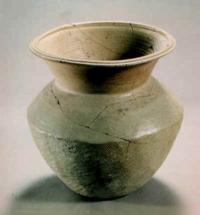 | Wine vessel. Proto-porcelain Zun, Shang Dynasty, 16th - 11th century B.C. Unearthed at a tomb of the Shang Dynasty at Zhengzhou in 1955. Kaolin clay porcelain with a thin layer of green glaze on the surface. This vessel is the earliest porcelain discovered in China so far. |
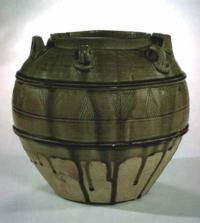 | Green-glazed porcelain jar with six loop handles. 7th year of Wuping's reign of the Northern Qi Dynasty, 576 AD. Unearthed at Puyang, Henan. Decorated with lines, circles, triangles, ducks and tree designs. |
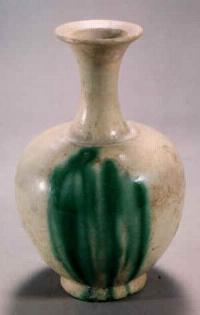 | White-glazed vase with green spot. 6th year of Wuping's reign of the Northern Qi Dynasty, 575 AD. Unearthed at Anyang, Henan. The vase is the earlist white-glazed porcelain in China so far. The production of white chinaware started in the Northern Qi Dynasty . The technique required for making white chinaware is more difficult than for making green chinaware. The key factor in making white porcelain is that the content of the iron element in the clay must be kept below one percent. The production of white porcelain laid a solid foundation for the production and prosperity of the varied colourful porcelain in the later dynasties. |
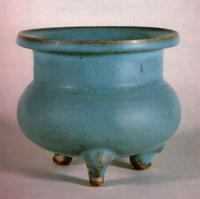 | Sky blue glaze porcelain incense burner. Jun ware, Northern Song Dynasty, 960-1127. Unearthed at Yuzhou, Henan. Sky blue glaze is the base colour of the Jun ware. The three interior marks were left by the spurs used to support a ware. |
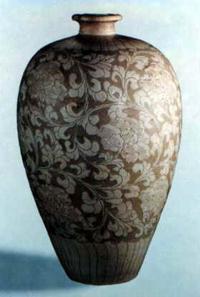 | White-glazed mei-ping vase with carved floral design. Northern Song Dynasty, 960-1127. Unearthed at Tangyin, Henan. The technique of the carved design is unique. The craftsmen painted twining peonies and vine on the vase, then they scraped the white glaze to expose the brown clay except the designs. The flowers are pure white and vivid on a brown ground, giving a strong colour contrast. |
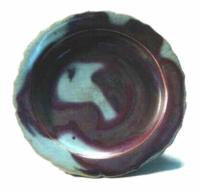 | Mallow-shaped plate in rose purple glaze. Jun ware, Song Dynasty, 960-1279. Unearthed at Fangcheng, Henan. Jun ware is named after Junzhou where it was produced, and the site of the ruined kiln has been discovered in the present Yuzhou City, Henan Province. The basic colour of the Jun ware is sky blue. The technique of yaobian is often used, which refers to the changes of tints of colours by control of the temperature of the kiln. |
Henan Museum home page: http://www.chnmus.net/ |
|